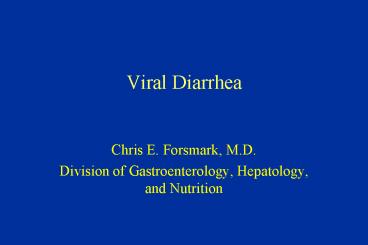Viral Diarrhea - PowerPoint PPT Presentation
1 / 49
Title:
Viral Diarrhea
Description:
Approx 180,000 hospitalizations/year in children 5. Mortality rare ... gastrointestinal involvement (colon) Cytomegalovirus colitis. Cytomegalovirus ... – PowerPoint PPT presentation
Number of Views:324
Avg rating:3.0/5.0
Title: Viral Diarrhea
1
Viral Diarrhea
- Chris E. Forsmark, M.D.
- Division of Gastroenterology, Hepatology, and
Nutrition
2
Virus Types
- Viral gastroenteritis
- Rotavirus
- Caliciviruses (Norovirus)
- Adenovirus
- Astrovirus
- Others (Torovirus, coronavirus,pestivirus)
- Viral colitis
- Cytomegalovirus
3
Magnitude of the Problem
4
Magnitude of the Problem
- Developing countries
- 2.6 episodes/child/year in children lt 5
- 700 million episodes/year
- 3-5 million deaths/year
- United States
- Approx 180,000 hospitalizations/year in children
lt 5 - Mortality rare
5
(No Transcript)
6
(No Transcript)
7
Viral Gastroenteritis in Children
8
Rotavirus
- Discovered in 1973
- Worldwide distribution
- All children exposed by age 4-5
- Double stranded RNA virus
- Several groups (A-E vs G-P)
- Most common cause of viral diarrhea
- 35 hospitalized, 10 community
9
Rotavirus
10
Rotavirus
11
Rotavirus
12
Percentage of Rotavirus tests with positive
results from US
13
Rotavirus structure
Most common serotypes G1, G2, G3, G4, P1(8)
14
Transmission of Rotavirus
- Fecal-oral
- Contaminated water supplies
- Poor hygiene
- Food
- Fomites
15
Rotavirus Clinical Syndromes
- Childhood gastroenteritis
- Endemic in tropics
- Winter in temperate zone
- Outbreaks
- Day care centers
- Hospitals
- Immunocompromised adults
16
How does Rotavirus cause diarrhea?
- Injures intestinal epithelium
- Malabsorption
- Increases secretion by epithelium
17
Diarrhea Classification
- Pathophysiology
- Osmotic
- Secretory
- Exudation
- Abnormal motility
- Duration
- Acute (lt 6 weeks)
- Chronic (gt 6 weeks)
18
(No Transcript)
19
(No Transcript)
20
(No Transcript)
21
Osmotic diarrhea
- Def Increased amounts of poorly absorbed,
osmotically active solutes in gut lumen - Interferes with reabsorption of water
- Solutes are ingested
- magnesium
- sorbitol
- malabsorption of food (mucosal injury, lactase
deficiency)
22
Secretory diarrhea
- Excess secretion of electrolytes, fluid across
mucosa - Usually coupled with decrease in absorption
- Watery, high-volume diarrhea with dehydration
- Enterotoxins Cholera, E. coli, food poisoning,
Rotavirus, Norwalk virus
23
(No Transcript)
24
(No Transcript)
25
Rotavirus Clinical Syndromes
- Asymptomatic carriers
- Diarrheal illness
- 2-3 day incubation period
- diarrhea, vomiting fever 3-7 days
- high infectivity
- Complications
- dehydration
- chronic diarrhea
- dissemination
- NEC
26
Diagnosis of rotavirus
- Electron microscopy
- Small intestine
- Stool
- Antigen in stool
- commercial ELISA
- research PCR, nucleic acid probes
27
Therapy for rotavirus
- Rehydration
- ORT
- Intravenous
- Probiotics
- lactobacilllus GG
- Bismuth
28
Oral rehydration solutions
29
(No Transcript)
30
(No Transcript)
31
Prevention of Rotavirus
- Natural immunity 93 protective (sIgA)
- Vaccination
- Monovalent (G1P8) attentuated human Rotarix
- 85 efficacy (G1P8 most common)
- Oral dose at 2 and 4 months of age
- Pentavalent reassortent rotavirus Rotateq
- 95-98 efficacy against most common serotypes G1,
G2, G3, G4, P1(8) - Oral dose at 2,4,6 months of age
- Universal infant immunization is recommended
32
Calicivirus
- Norovirus Norwalk virus and Norwalk-like
- Sapovirus Sapporo-like viruses
- Vesivirus
- Lagovirus
- All single stranded RNA viruses
33
Norovirus or
34
(No Transcript)
35
Norovirus
36
Norovirus
- winter vomiting disease 1968, Norwalk OH
- Most common cause of nonbacterial gastroenteritis
epidemics (40-50) - Explosive epidemics
- camps, cruise ships, nursing homes, amusement
parks, military facilities, hospitals - Food borne illness
- raw shellfish
37
Food-borne illness
38
Shellfish-borne infections
39
Norwalk virus Clinical Features
- 24-48 hour incubation period
- vomiting prominent
- watery diarrhea 1-3 days
- affects all ages
- antibodies in 60 of adults
- complications rare
- immunocompromised
40
Norovirus
- Readily transmissible (median infectious dose
only 18 viruses - Viral shedding at very high levels (7.7 X 1010
viruses/gm stool), persisting weeks after
symptoms have resolved - Over the past decade, most epidemics associated
with emerging G II.A strain (Farmington Hills
strain)
41
How does Norwalk virus cause diarrhea?
- Infection affects proximal small bowel
- Patchy mucosal injury with villous blunting
- Malabsorption
- Excess secretion likely but no enterotoxin
identifired - Cause of vomiting unclear
42
Norwalk virus
2 days
6 days
Before ingestion
43
Diagnosis of Norwalk virus
- Clinical diagnosis (exclude rotavirus)
- Immune EM
- Serology of antibody response
- enzyme immunoassays
- RT-PCR
- oligonucleotide probes
44
Treatment of Norwalk virus
- Rehydration
- Supportive measures
- bismuth
- antidiarrheals (Lomotil, Immodium)
45
Other viruses causing gastroenteritis
- Astrovirus
- children, outbreaks
- Adenovirus
- children, prolonged course
- Torovirus
- children, bovine pathogen
46
Cytomegalovirus
- Herpesvirus
- Immune competent
- Mononucleosis-type syndrome
- Immunocompromised
- retinitis
- hepatitis
- gastrointestinal involvement (colon)
47
(No Transcript)
48
Cytomegalovirus colitis
49
Cytomegalovirus
- Diagnosis requires tissue biopsy
- Occurs in immuno-compromised patients
- Chemotherapy
- Steroids
- HIV
- Transplant
- Difficult to treat































